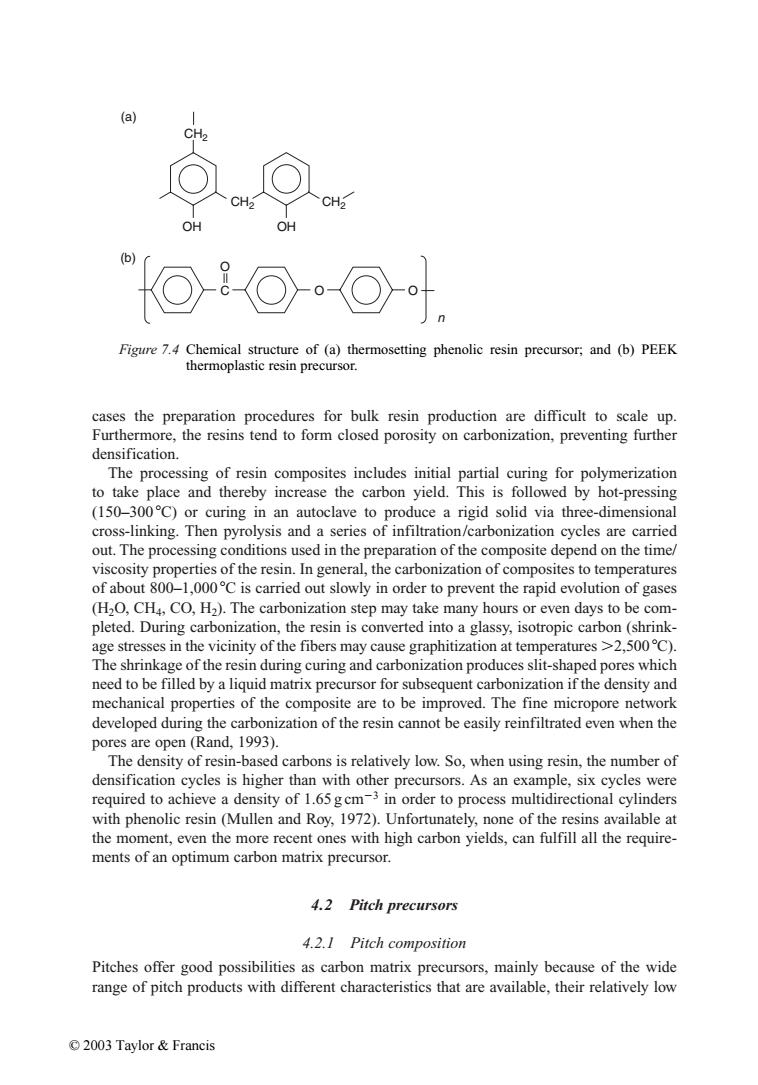正在加载图片...

(a) CH2 CH CH2 Figure 7.4 Chemical structure of(a)thermosetting phenolic resin precursor;and (b)PEEK thermoplastic resin precursor. cases the preparation procedures for bulk resin production are difficult to scale up. Furthermore,the resins tend to form closed porosity on carbonization,preventing further densification. The processing of resin composites includes initial partial curing for polymerization to take place and thereby increase the carbon yield.This is followed by hot-pressing (150-300C)or curing in an autoclave to produce a rigid solid via three-dimensional cross-linking.Then pyrolysis and a series of infiltration/carbonization cycles are carried out.The processing conditions used in the preparation of the composite depend on the time/ viscosity properties of the resin.In general,the carbonization of composites to temperatures of about 800-1,000C is carried out slowly in order to prevent the rapid evolution of gases (H2O,CH4,CO,H2).The carbonization step may take many hours or even days to be com- pleted.During carbonization,the resin is converted into a glassy,isotropic carbon(shrink- age stresses in the vicinity of the fibers may cause graphitization at temperatures >2,500C). The shrinkage of the resin during curing and carbonization produces slit-shaped pores which need to be filled by a liquid matrix precursor for subsequent carbonization if the density and mechanical properties of the composite are to be improved.The fine micropore network developed during the carbonization of the resin cannot be easily reinfiltrated even when the pores are open(Rand,1993). The density of resin-based carbons is relatively low.So,when using resin,the number of densification cycles is higher than with other precursors.As an example,six cycles were required to achieve a density of 1.65 gcm-3 in order to process multidirectional cylinders with phenolic resin(Mullen and Roy,1972).Unfortunately,none of the resins available at the moment,even the more recent ones with high carbon yields,can fulfill all the require- ments of an optimum carbon matrix precursor. 4.2 Pitch precursors 4.2.1 Pitch composition Pitches offer good possibilities as carbon matrix precursors,mainly because of the wide range of pitch products with different characteristics that are available,their relatively low ©2003 Taylor&FrancisCH2 CH2 CH2 (a) O O O n (b) C OH OH cases the preparation procedures for bulk resin production are difficult to scale up. Furthermore, the resins tend to form closed porosity on carbonization, preventing further densification. The processing of resin composites includes initial partial curing for polymerization to take place and thereby increase the carbon yield. This is followed by hot-pressing (150–300 C) or curing in an autoclave to produce a rigid solid via three-dimensional cross-linking. Then pyrolysis and a series of infiltration/carbonization cycles are carried out. The processing conditions used in the preparation of the composite depend on the time/ viscosity properties of the resin. In general, the carbonization of composites to temperatures of about 800–1,000 C is carried out slowly in order to prevent the rapid evolution of gases (H2O, CH4, CO, H2). The carbonization step may take many hours or even days to be completed. During carbonization, the resin is converted into a glassy, isotropic carbon (shrinkage stresses in the vicinity of the fibers may cause graphitization at temperatures
2,500 C). The shrinkage of the resin during curing and carbonization produces slit-shaped pores which need to be filled by a liquid matrix precursor for subsequent carbonization if the density and mechanical properties of the composite are to be improved. The fine micropore network developed during the carbonization of the resin cannot be easily reinfiltrated even when the pores are open (Rand, 1993). The density of resin-based carbons is relatively low. So, when using resin, the number of densification cycles is higher than with other precursors. As an example, six cycles were required to achieve a density of 1.65 g cm3 in order to process multidirectional cylinders with phenolic resin (Mullen and Roy, 1972). Unfortunately, none of the resins available at the moment, even the more recent ones with high carbon yields, can fulfill all the requirements of an optimum carbon matrix precursor. 4.2 Pitch precursors 4.2.1 Pitch composition Pitches offer good possibilities as carbon matrix precursors, mainly because of the wide range of pitch products with different characteristics that are available, their relatively low Figure 7.4 Chemical structure of (a) thermosetting phenolic resin precursor; and (b) PEEK thermoplastic resin precursor. © 2003 Taylor & Francis